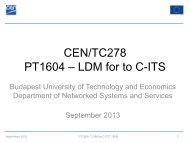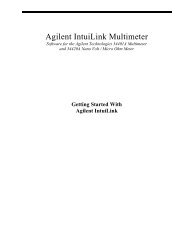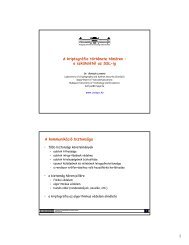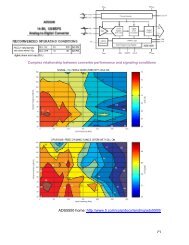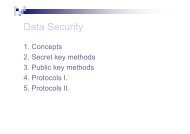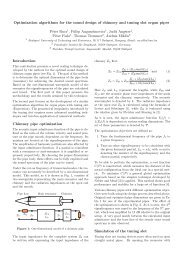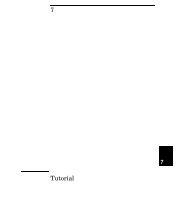IntuiLink Waveform Editor
IntuiLink Waveform Editor
IntuiLink Waveform Editor
Create successful ePaper yourself
Turn your PDF publications into a flip-book with our unique Google optimized e-Paper software.
Types of noise<br />
Many tests of electronic equipment and<br />
components use white noise, pink noise,<br />
or Brown noise. The figure shows the<br />
four types of noise plotted with Equation<br />
Calculator.<br />
With white noise, any amplitude is as<br />
likely to occur at any point as any other<br />
amplitude. The power spectrum of white<br />
noise is, therefore, independent of<br />
frequency (it has a flat frequency<br />
response). You easily can create white<br />
noise in software by using a randomnumber<br />
generator. Software random-<br />
Gaussian white noise, brown noise and pink noise.<br />
Clockwise from upper left, random white noise,<br />
number generators will produce random<br />
numbers between 0 and 1, which you often need to shift to between –0.5 and +0.5 so the<br />
amplitude of the noise centers at about zero.<br />
Unfortunately, white noise doesn't necessarily represent any naturally occurring phenomenon.<br />
More often, you want a Gaussian distribution of power so most of the points have a value near<br />
zero. Every now and then you want a point with a value of ±0.5, which a Gaussian distribution<br />
will give you. White noise with a Gaussian distribution is also called "normal white noise."<br />
Pink noise, also known as 1/f noise, is used in audio testing. It has an even power distribution<br />
when you view frequency on a logarithmic scale (Ref. 1). Pink noise has the same power in the<br />
octave 200 Hz to 400 Hz as it does in the octave 2000 Hz to 4000 Hz, which makes it sound<br />
natural to our ears. It's frequency power spectra rolls off at 10 dB per decade, or approximately<br />
3 dB per octave.<br />
With brown noise, the integral of white noise, each point in the waveform depends on the value<br />
of the previous point. Each value moves slightly from its previous position, up or down, in a<br />
random fashion, or "random walk." You create brown noise by adding a random number to the<br />
previous value. Brown noise has a frequency spectrum of 1/f 2 and has a power density roll-off<br />
at 20 dB per decade (6 dB/octave). The name "brown noise" comes from the Scottish botanist<br />
Brown, as in Brownian motion, not the color brown (Ref 2).<br />
References<br />
1. "DSP generation of Pink (1/f) Noise," www.firstpr.com.au/dsp/pink-noise<br />
2. Schroeder, Manfred, Fractals, Chaos, Power Laws, W.H. Freeman and Co., New York, NY,<br />
1991.<br />
4



